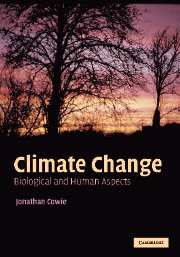Book contents
- Frontmatter
- Contents
- Introduction
- Acknowledgements
- 1 An introduction to climate change
- 2 Principal indicators of past climates
- 3 Past climate change
- 4 The Oligocene to the Quaternary: climate and biology
- 5 Present climate and biological change
- 6 Current warming and likely future impacts
- 7 The human ecology of climate change
- 8 Sustainability and policy
- Appendix 1 Glossary and abbreviations
- Appendix 2 Bio-geological chronology
- Appendix 3 Calculations of energy demand/supply and orders of magnitude
- Appendix 4 The IPCC 2007 report
- Index
- References
Appendix 3 - Calculations of energy demand/supply and orders of magnitude
Published online by Cambridge University Press: 17 December 2010
- Frontmatter
- Contents
- Introduction
- Acknowledgements
- 1 An introduction to climate change
- 2 Principal indicators of past climates
- 3 Past climate change
- 4 The Oligocene to the Quaternary: climate and biology
- 5 Present climate and biological change
- 6 Current warming and likely future impacts
- 7 The human ecology of climate change
- 8 Sustainability and policy
- Appendix 1 Glossary and abbreviations
- Appendix 2 Bio-geological chronology
- Appendix 3 Calculations of energy demand/supply and orders of magnitude
- Appendix 4 The IPCC 2007 report
- Index
- References
Summary
Calculations of energy demand/supply
From Chapter 7 onwards there are a number of depictions of global energy supply and demand. The following definitions have been applied in constructing these graphs of energy statistics.
Where statistics are given in millions of tonnes of oil equivalent (mtoe) for quantities of nuclear and renewable energy (such as hydro electric power) they are expressed in terms of the oil equivalent as if the energy was generated by an oil-fired electricity-generating plant with an efficiency of around 33%. Consequently it is possible to make some comparison and to see how these non-fossil energy sources (could) displace oil sources.
Historic proportional energy-supply estimates prior to 1950 are taken from Morgan and Murray (1976). Subsequent estimates were taken from the US Government's Energy Information Administration www.eia.doe.gov in autumn 2004 and spring 2005 as well as the BP Statistical Review of World Energy (1990, 2000, 2005) and adapted where necessary, as per previous power-station efficiency assumptions. The Worldwatch Institute's Vital Signs series (2003), which in turn draws on additional sources, was used as a check on statistics post-1950. The UK Department of Trade and Industry's (www.dti.gov.uk) Energy Trends was similarly used as a check for UK data.
- Type
- Chapter
- Information
- Climate ChangeBiological and Human Aspects, pp. 478 - 479Publisher: Cambridge University PressPrint publication year: 2007



